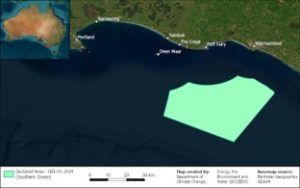A number of steps have occurred towards development of Australia's offshore wind industry, although significant challenges remain.
On 6 March 2024, the Southern Ocean region off the coast of Port Fairy and Warrnambool was declared an offshore wind zone under the Offshore Electricity Infrastructure Act 2021. Applications for feasibility licences are now open, closing 2 July 2024.
Regulations and an updated application form have been made, which will facilitate progress of Gippsland and Hunter applications through the 'overlapping application group' process, and ACCC has granted an interim authorization of discussions within an overlapping application group. As at the date of this update, indications are that offers of feasibility licences are imminent.
VicGrid has announced its study area for transmission connecting the first 2GW of Gippsland offshore wind, with a connection point around Giffard and transmission to the Latrobe Valley.
The Southern Ocean declared area
The Declared Area is 1,030km2, with the Department of Climate Change, Energy, the Environment and Water (DCCEEW) anticipating commercial projects in the Declared Area would generate up to 2.9GW. Noting the maximum area of a feasibility licence is 700km2 and feasibility licences cannot overlap, we anticipate there may be overlapping applications made, potentially leading to an overlapping application group process, and the number of licences ultimately awarded will be minimal.
The area declared is approximately 20% the size of the proposed area on which the Minister consulted last year. Notably, it does not include waters off of South Australia, the Discovery Bay Coastal Park nor Portland in Victoria.
Declared Area

Source: DCCEEW
Declared area shown within proposed area for consultation

Source: DCCEEW
Updated Guidelines and Registrar's Forms Guidance (March 2024) will apply to applications for feasibility licences in the Southern Ocean declared area.
Consultation outcomes
The Minister declared the area approximately 6 months following the closure of public consultation on the proposed area. Consultation was open 28 June to 31 August 2023, with DCCEEW receiving over 3,000 submissions.
Key outcomes for the Southern Ocean declared area following consultation include:
- The area adjacent to the South Australian coast has been excluded, following the South Australian Government's submission (among others) recommending that that area not be included. The Government cited concerns including impacts on the rock lobster industry and areas of biological, environmental significance.
- DCCEEW states the area now avoids major commercial fishing grounds. We note the declared area contains conditions that future feasibility licence holders will need to address in their management plans, including the need to consult with concession or licence holders under the Commonwealth Fisheries Management Act 1991 or the Victorian Fisheries Act 1999, as well as the Department of Defence and the Australian Maritime Safety Authority. These requirements are similar to those required of future feasibility licence holders within the Hunter and Gippsland declared areas.
- To address visual amenity concerns, the declared area is a minimum of 15km from the nearest shoreline, 20km offshore at Port Fairy, and over 45km from Portland and the Cape Nelson Lighthouse.
- DCCEEW states revisions were made to address First Nations groups' concerns and the cultural significance of Deen Maar, an Indigenous Protected Area.
Decisions pending on Gippsland and Hunter feasibility licences; key steps have been taken to facilitate overlapping group process
While offshore wind proponents are preparing feasibility licence applications for the Southern Ocean Zone, the nascent legislative regime and industry continues to be established.
Regulations were made in March 2024 that will facilitate publication of information when decisions are made on feasibility licence applications in the Gippsland and Hunter areas, and the application form has been updated to allow for 'resubmitted' applications following an overlapping group process.
Importantly, in respect of industry concerns regarding Competition and Consumer Act 2010 (Cth) compliance during the overlapping application groups process, on 20 March 2024 ACCC granted an urgent interim authorisation to allow feasibility licence applications in overlapping application groups to communicate, and to propose, enter into and give effect to agreements for the purpose of removing overlaps in their feasibility licence applications for the Gippsland and Hunter regions (subject to limitations). The authorisation is subject to scope limitations but also authorises DCCEEW and the Offshore Infrastructure Registrar to facilitate the discussions, subject to limitations. DCCEEW's application for the interim authorization had indicated that feasibility licence decisions for the Gippsland area were expected by the end of March 2024, and for the Hunter region by July 2024. The ACCC has stated that it granted the interim authorisation to prevent delays in the feasibility licence process, recognising 'the importance of supporting the development of renewable energy infrastructure and to address perceived risks by industry participants about their role in this licensing process'.
DCCEEW has made an application to ACCC for substantive authorisation for a period of 3 years to 15 March 2027. The ACCC is seeking submissions on DCCEEW's application by 12 April 2024.
Consultation on proposed Bunbury declared area
Consultation on the proposed Bunbury declared area opened on 20 February 2024 and will close on 3 May 2024. DCCEEW community drop-in sessions commenced on 19 March 2024 and have seen significant attendances at Bunbury, Busselton, Harvey and Mandurah. Whilst some members of the public have shown support for the declared area, concerns have been raised during the consultation including in relation to the impacts on marine environment and the accessibility of the consultation itself.
Industry awaits critical Regulations
We continue to await Regulations addressing management plans and payment of financial security, which are necessary before feasibility activities can commence under a licence. We are hearing from industry that the delay and uncertainty on these matters, and consequent delay to commencement of feasibility activities, will impact on the expected program for project development and participation in CfD processes.
Victorian OSW transmission
VicGrid has announced its study area for the new transmission infrastructure that will connect offshore wind projects in Gippsland, to the electricity grid in the Latrobe Valley. The wide study area generally follows the Basslink corridor, starting approximately 6km from the coast with connection near Giffard, heading northwest past Stradbroke West to Willung and then across to Flynns Creek. Helpfully for proponents that submitted referrals for projects with connections to the Latrobe Valley, the study area ends at Loy Yang Power Station. The transmission infrastructure considered under the study area is intended to support Victoria's first offshore wind target of at least 2 gigawatts by 2032. VicGrid legislative amendments
The National Electricity (Victoria) Amendment (VicGrid) Bill 2024 (Vic) was introduced to the Victorian Parliament on 5 March 2024. The Bill establishes the statutory powers of the VicGrid CEO, including to set the Victorian Transmission Plan and approve the foreshadowed payments to landholders in relation to transmission interests, in addition to compensation for easements.
VicGrid is in the process of preparing its first Victorian Transmission Plan, which per the Bill (section 59), will set out an optimal set of projects that address the planning and development needs over a 15 year period initially, and over 25 year periods in each subsequent plan. VicGrid has stated the first plan is targeted for final publication in mid-2025.
The Bill also outlines the process by which the Victorian Minister for Energy and Resources can declare Renewable Energy Zones. When making a REZ order, the Minister must have regard to the current Victorian transmission plan and the Victorian transmission planning objective.
Energy and public land reforms to facilitate offshore wind connection
The Energy and Public Land Legislation Amendment (Enabling Offshore Wind Energy) Bill 2024 (Vic) was introduced into Victorian Parliament on 5 March 2024.
Of note, the Bill seeks to:
- facilitate investigations, through amending the Land Act 1958, the Crown Land (Reserves) Act 1978, the Forests Act 1958, and the National Parks Act 1975 to create a new category of licence that enables offshore wind proponents to investigate offshore wind electricity transmission infrastructure on public land, with a tenure of 21 years.
- enable the Ministers administering these Acts to enter into agreements with electricity companies for the purpose of construction and operation of new electricity infrastructure and allows the Minister to enter into agreements under the National Parks Act 1975 with offshore wind energy generation companies.
- amends the Electricity Industry Act 2000 to provide the Minister with a power to declare an offshore wind energy generation company. The National Parks Act 1975 will also be amended to reference an offshore wind energy generation company within the meaning of a 'public authority'.
Government funding support for Australian offshore wind projects
At this stage, it is not certain how offshore wind will be funded, specifically whether and to what extent the Commonwealth and State governments will subsidise offshore wind, for example if costs will be passed through to energy bills or whether government will separately subsidise projects.
The Victorian Government in its Offshore Wind Implementation Statement 3 (December 2023), states the Government's commitment to development of a comprehensive support package, integrated with national capacity incentives, for the first tranche of offshore wind. The Government has indicated its proposed support package includes a Contract for Difference plus availability-style payments. Implementation Statement 3 states the Government's competitive auction process for the support package will include an Expression of Interest phase targeted to close in Q1 of 2025, followed by a Request for Proposal phase targeted to close in Q1 of 2026 and contract negotiation and award targeted to occur later in 2026.
The content of this article is intended to provide a general guide to the subject matter. Specialist advice should be sought about your specific circumstances.




